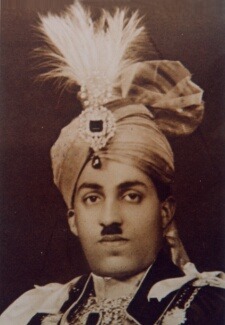|
Sidi Muhammad Haider Khan
Sidi Muhammad Haider Khan was the Nawab of Sachin from 1930 until his death in 1970. Biography He was born on 11 September 1909 as the eldest son of Ibrahim Muhammad Yakut Khan III and his wife Fatima Sultan Jahan. He was educated at the Rajkumar College, Rajkot. Upon the death of his father on 19 November 1930, he succeeded him as the Nawab of Sachin. He was invested with ruling powers on 5 February 1931 by the Political Agent on two conditions: firstly, that for a period of two years, his Diwan would be appointed with the approval of the Government; and secondly, that in all important matters of State policy, he would abide by the advice of the Political Agent. He acceded Sachin to the Dominion of India in August 1947. He married three times.{{Cite book , last=Francis Low , url=https://archive.org/details/in.ernet.dli.2015.109605 , title=The Indian Year Book Of 1939 To 40 , date=1939 , pages=1186 His first marriage was to Arjumand Bano Sarkar-i-Aliya Nawab Nusrat Zamani ... [...More Info...] [...Related Items...] OR: [Wikipedia] [Google] [Baidu] |
Nawab
Nawab is a royal title indicating a ruler, often of a South Asian state, in many ways comparable to the Western title of Prince. The relationship of a Nawab to the Emperor of India has been compared to that of the Kingdom of Saxony, Kings of Saxony to the German Emperor. In earlier times the title was ratified and bestowed by the reigning Mughal emperor to semi-autonomous Muslim rulers of subdivisions or princely states in the Indian subcontinent loyal to the Mughal Empire, for example the Nawabs of Bengal. "Nawab" usually refers to males and literally means ''Viceroy''; the female equivalent is "Begum" or "''Nawab Begum''". The primary duty of a Nawab was to uphold the sovereignty of the Mughal emperor along with the administration of a certain province. The title of "nawabi" was also awarded as a personal distinction by the paramount power, similar to a British peerage, to persons and families who ruled a princely state for various services to the Government of British Raj ... [...More Info...] [...Related Items...] OR: [Wikipedia] [Google] [Baidu] |
Wali-ahad Sahib
Sahib or Saheb () is a term of address originating from Arabic (). As a loanword, ''Sahib'' has passed into several languages, including Persian, Kurdish, Turkish, Azerbaijani, Kazakh, Uzbek, Turkmen, Tajik, Crimean Tatar, Urdu, Hindi, Punjabi, Pashto, Bengali, Gujarati, Marathi, Rohingya and Somali. During medieval times, it was used either as an official title or an honorific. Now, in South and Central Asia, it is almost exclusively used to give respect to someone higher or lower. The honorific has largely been replaced with ''sir''. In the Tibeto-Burman language of Mizo, it is shorten as sâp, referring to people of European descent. Derived non-ruling princes' titles Sahibzada ''Sahibzada'' is a princely style or title equivalent to, or referring to a young prince. This derivation using the Persian suffix ''-zada(h)'', literally 'born from' (or further male/female descendant; compare ''Shahzada'') a ''Sahib'', was also (part of) the formal style for some pri ... [...More Info...] [...Related Items...] OR: [Wikipedia] [Google] [Baidu] |
Nawabs Of India
Nawab is a royal title indicating a ruler, often of a South Asian state, in many ways comparable to the Western title of Prince. The relationship of a Nawab to the Emperor of India has been compared to that of the Kings of Saxony to the German Emperor. In earlier times the title was ratified and bestowed by the reigning Mughal emperor to semi-autonomous Muslim rulers of subdivisions or princely states in the Indian subcontinent loyal to the Mughal Empire, for example the Nawabs of Bengal. "Nawab" usually refers to males and literally means ''Viceroy''; the female equivalent is "Begum" or "''Nawab Begum''". The primary duty of a Nawab was to uphold the sovereignty of the Mughal emperor along with the administration of a certain province. The title of "nawabi" was also awarded as a personal distinction by the paramount power, similar to a British peerage, to persons and families who ruled a princely state for various services to the Government of India. In some cases, the t ... [...More Info...] [...Related Items...] OR: [Wikipedia] [Google] [Baidu] |
Indian Muslims
Islam is India's second-largest religion, with 14.2% of the country's population, or approximately 172.2 million people, identifying as adherents of Islam in a 2011 census. India also has the third-largest number of Muslims in the world. The majority of India's Muslims are Sunni, with Shia making up around 15% of the Muslim population. Islam spread in Indian communities along the Arab coastal trade routes in Gujarat and in Malabar Coast shortly after the religion emerged in the Arabian Peninsula. Islam arrived in the inland of Indian subcontinent in the 7th century when the Arabs invaded and conquered Sindh and later arrived in Punjab and North India in the 12th century via the Ghaznavids and Ghurids conquest and has since become a part of India's religious and cultural heritage. The Barwada Mosque in Ghogha, Gujarat built before 623 CE, Cheraman Juma Mosque (629 CE) in Methala, Kerala and Palaiya Jumma Palli (or The Old Jumma Masjid, 628–630 CE) in Kilakarai, T ... [...More Info...] [...Related Items...] OR: [Wikipedia] [Google] [Baidu] |
1970 Deaths
Events January * January 1 – Unix time epoch reached at 00:00:00 UTC. * January 5 – The 7.1 1970 Tonghai earthquake, Tonghai earthquake shakes Tonghai County, Yunnan province, China, with a maximum Mercalli intensity scale, Mercalli intensity of X (''Extreme''). Between 10,000 and 14,621 are killed and 30,000 injured. * January 15 – After a 32-month fight for independence from Nigeria, Biafran forces under Philip Effiong formally surrender to General Yakubu Gowon, ending the Nigerian Civil War. February * February 1 – The Benavídez rail disaster near Buenos Aires, Argentina (a rear-end collision) kills 236. * February 10 – An avalanche at Val-d'Isère, France, kills 41 tourists. * February 11 – ''Ohsumi (satellite), Ohsumi'', Japan's first satellite, is launched on a Lambda-4 rocket. * February 22 – Guyana becomes a Republic within the Commonwealth of Nations. * February – Multi-business Conglomerate (company), conglomerate Virgin Group is founded as a ... [...More Info...] [...Related Items...] OR: [Wikipedia] [Google] [Baidu] |


